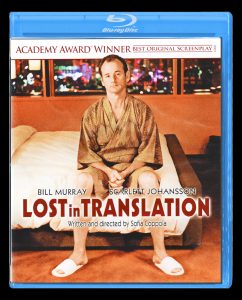
Gil Asakawa
I get it. I understand. Traveling to someplace you’ve never been, where the culture and language is foreign to you, can be challenging. I know lots of Americans — including some Japanese Americans — who’ve either been hesitant to go to Japan or who’ve gone and struggled to adjust to the oddly familiar, yet unfamiliar, sights, sounds, tastes and culture. It can be discombobulating.
That’s the opening premise of a movie that was released 20 years ago, in 2003: “Lost in Translation.”
 The film was written and directed by Sofia Coppola, and it was well-received critically and at the boxoffice. Coppola even won an Oscar for best original script the next year. The plot of the film is about two Americans, a fading older movie star, played by Bill Murray, and a young girl right out of grad school, played by Scarlett Johansson, who is left to wander Tokyo on her own because her photographer boyfriend, who she traveled with, is gone on assignment a lot of the time during the movie. Both characters’ relationships are failing. Murray has sad and disconnected phone calls with his wife; so does Johansson with her boyfriend.
The film was written and directed by Sofia Coppola, and it was well-received critically and at the boxoffice. Coppola even won an Oscar for best original script the next year. The plot of the film is about two Americans, a fading older movie star, played by Bill Murray, and a young girl right out of grad school, played by Scarlett Johansson, who is left to wander Tokyo on her own because her photographer boyfriend, who she traveled with, is gone on assignment a lot of the time during the movie. Both characters’ relationships are failing. Murray has sad and disconnected phone calls with his wife; so does Johansson with her boyfriend.
The two meet each other at the Shinjuku Park Hyatt Hotel, which is a character all its own, out of boredom, ennui and loneliness. The film is about their relationship, which is emotional and not sexual, or at least, not sexually fulfilled. They kiss as Murray’s character leaves for the airport to fly back to the U.S., which serves as a happy ending of sorts, while Johansson is left in Tokyo waiting for her boyfriend.
Coppola has said that the movie was her love note to Tokyo. “Lost in Translation” was released the same year as two other movies set in Japan, “The Last Samurai,” a nonsensical historical representation starring Tom Cruise, and “Kill Bill: Volume 1,” which was partly set in Japan and has a pretty great, violent fight scene in a Tokyo restaurant that I got to eat at this past spring. But those two movies were not realistic representations of Japan or Tokyo. “Lost in Translation” wants to show the Tokyo that Coppola was familiar with and had visited many times.
Because of the 20th anniversary of the release on Sept. 12, there have been a few articles looking back on both the impact of the film and some of the issues that linger in the way “Lost in Translation” portrayed Tokyo.
The movie does a great job of showing a lyrical Tokyo, complete with colors and long shots. You can see the urban landscape in a way that’s downright poetic. But it also shows some of the problematic cultural things that Americans assume are what Japan is all about like young people with pink wigs getting wasted in karaoke bars — though having a drunk Japanese dude screaming the Sex Pistols’ punk anthem “God Save the Queen” is pretty funny.
I remember liking “Lost in Translation” when it came out but also feeling uncomfortable about some of it. I watched it this past week on Blu-ray, and I was mildly surprised to find that I didn’t hate it but have to admit that there are a couple of scenes that really bother me partly because I know more about the way stereotypes can be insidious sources of hate, including anti-Asian hate.
In one scene, Murray, who is in Japan to tape commercials for Suntory whisky, is sent a prostitute to his hotel room, and the way Japanese people mispronounce English becomes a running gag. The prostitute says, “Rip my stockings,” and Murray thinks she’s saying “lip” or “lick.” The scene is so offensive, it gives me a pit in my stomach.
In other scenes, Murray speaks to Japanese people with absolutely no consideration that they have no idea what he’s saying. He acts out the stereotype of the Ugly American, and if I give Coppola the benefit of the doubt, she’s making a statement about how this is wrong.
But I doubt many viewers get that message. Murray, in particular, displays such an awful sense of privilege and superiority that it’s hard to watch. He represents the worst of Americans that I’ve seen in Japan.
Johansson, on the other hand, does show some empathy and curiosity, something that Murray absolutely does not. She wanders into an Ikebana, or flower arranging, class in the hotel and is drawn in to creating a display.
Not surprisingly, Japanese food ends up being the target of ignorant Western perspectives. After a shabu-shabu meal, they both laugh about how awful it was that they have to cook their own food at the table.
Ultimately, the movie uses Japanese people, things, culture and everything in Tokyo as mere props — just an exotic, colorful and bewildering backdrop for these two characters’ tepid relationship.
As cinematic art, it’s worth noting that this was one of the first realistic depictions of Tokyo in a Hollywood movie partly because it was done on location with much of it done with available light and hand-held cameras with a small budget and guerilla crew. That makes it an interesting movie to watch. But for me, it’s not a great movie to pay attention to.
It may be interesting to pull out the disc, if there’s still such a thing as a disc player, in another 20 years to see how the movie has aged by then.
Gil Asakawa is the author of “Tabemasho! Let’s Eat! The Tasty History of Japanese Food in America.”



